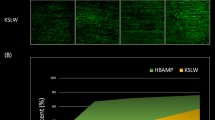ABSTRACT
Purpose
Development of dentotropic (tooth-binding) micelle formulations to improved efficacy and safety of antimicrobial therapy for dental plaque prevention and treatment.
Methods
Because of their excellent biocompatibility and biodegradability, diphosphoserine peptide and pyrophosphate were selected as the tooth-binding moieties to replace alendronate, which was used previously. Diphosphoserine peptide was conjugated to Pluronic P123 using “click” chemistry, whereas pyrophosphate was attached to P123 through an ester bond. The tooth-binding micelles (TBMs) were prepared by self-assembly of the modified P123 with the antimicrobial agent triclosan. The influence of human saliva and/or its components on TBMs’ drug-releasing profile, tooth-binding potential and binding stability was evaluated in vitro. S. mutans UA159 biofilm formed on hydroxyapatite (HA) discs was used to evaluate the TBMs’ therapeutic potential.
Results
Saliva does not affect triclosan release from TBMs. More than 60% of TBMs’ HA binding capacity was maintained in the presence of saliva. Less than 5% of TBMs bound to HA was released over 24 h in human saliva, protease or phosphatase, suggesting the retention properties of the TBMs will not be compromised due to the biodegradable nature of the binding moieties. In both in vitro biofilm prevention and treatment studies, the TBM treated group showed significantly lower CFU per HA disc compared to the controls (2-log reduction, p < 0.05).
Conclusion
The data from these studies suggest that the novel dentotropic micelle formulations bearing biodegradable tooth-binding moieties can be used as an effective and safe delivery tool for antimicrobials to improve dental plaque prevention and treatment.






Similar content being viewed by others
REFERENCES
Marsh PD, Bradshaw DJ. Dental plaque as a biofilm. J Ind Microbiol. 1995;15:169–75.
Kidd EA, Fejerskov O. What constitutes dental caries? Histopathology of carious enamel and dentin related to the action of cariogenic biofilms. J Dent Res. 2004;83(Spec No C):C35–8.
Albandar JM. Epidemiology and risk factors of periodontal diseases. Dent Clin N Am. 2005;49:517–32. v–vi.
Inaba H, Amano A. Roles of oral bacteria in cardiovascular diseases–from molecular mechanisms to clinical cases: Implication of periodontal diseases in development of systemic diseases. J Pharmacol Sci. 2010;113:103–9.
Persson GR, Persson RE. Cardiovascular disease and periodontitis: an update on the associations and risk. J Clin Periodontol. 2008;35:362–79.
Tonetti MS. Periodontitis and risk for atherosclerosis: an update on intervention trials. J Clin Periodontol. 2009;36 Suppl 10:15–9.
Teeuw WJ, Gerdes VE, Loos BG. Effect of periodontal treatment on glycemic control of diabetic patients: a systematic review and meta-analysis. Diabetes Care. 2010;33:421–7.
Gurav A, Jadhav V. Periodontitis and risk of diabetes mellitus. J Diabetes. 2010;3:21–8.
Mikuls TR, Payne JB, Reinhardt RA, Thiele GM, Maziarz E, Cannella AC, et al. Antibody responses to Porphyromonas gingivalis (P. gingivalis) in subjects with rheumatoid arthritis and periodontitis. Int Immunopharmacol. 2009;9:38–42.
Paju S, Scannapieco FA. Oral biofilms, periodontitis, and pulmonary infections. Oral Dis. 2007;13:508–12.
Chen F, Wang D. Novel technologies for the prevention and treatment of dental caries: a patent survey. Expert Opin Ther Pat. 2010;20:681–94.
Marsh PD. Controlling the oral biofilm with antimicrobials. J Dent. 2010;38 Suppl 1:S11–5.
Chen F, Rice KC, Liu XM, Reinhardt RA, Bayles KW, Wang D. Triclosan-loaded tooth-binding micelles for prevention and treatment of dental biofilm. Pharm Res. 2010;27:2356–64.
Chen F, Liu XM, Rice KC, Li X, Yu F, Reinhardt RA, et al. Tooth-binding micelles for dental caries prevention. Antimicrob Agents Chemother. 2009;53:4898–902.
Russell RG. Bisphosphonates: mode of action and pharmacology. Pediatrics. 2007;119 Suppl 2:S150–62.
Silvermanand SL, Landesberg R. Osteonecrosis of the jaw and the role of bisphosphonates: a critical review. Am J Med. 2009;122:S33–45.
Makrodimitris K, Masica DL, Kim ET, Gray JJ. Structure prediction of protein-solid surface interactions reveals a molecular recognition motif of statherin for hydroxyapatite. J Am Chem Soc. 2007;129:13713–22.
Hefferren JJ. Historical view of dentifrice functionality methods. J Clin Dent. 1998;9:53–6.
Joiner A. Whitening toothpastes: a review of the literature. J Dent. 2010;38 Suppl 2:e17–24.
Mankodi S, Sowinski J, Davies R, Ellwood R, Bradshaw B, Petrone ME, et al. A six-week clinical efficacy study of a tooth whitening tartar control dentifrice for the removal of extrinsic tooth stain. J Clin Dent. 1999;10:99–102.
Shellis RP, Addy M, Rees GD. In vitro studies on the effect of sodium tripolyphosphate on the interactions of stain and salivary protein with hydroxyapatite. J Dent. 2005;33:313–24.
Murchison HH, Barrett JF, Cardineau GA, Curtiss 3rd R. Transformation of Streptococcus mutans with chromosomal and shuttle plasmid (pYA629) DNAs. Infect Immun. 1986;54:273–82.
Carles J. Colorimetric microdetermination of phosphorus. Bull Soc Chim Biol (Paris). 1956;38:255–7.
Biswas I, Drake L, Biswas S. Regulation of gbpC expression in Streptococcus mutans. J Bacteriol. 2007;189:6521–31.
Jett BD, Hatter KL, Huycke MM, Gilmore MS. Simplified agar plate method for quantifying viable bacteria. Biotechniques. 1997;23:648–50.
Ohkawa K, Saitoh A, Yamamoto H. Synthesis of poly(O-phospho-L-serine) and its structure in aqueous solution. Macromol Rapid Commun. 1999;20:619–21.
Donninger C, Popjak G. An improved synthesis of isopentenyl pyrophosphate. Biochem J. 1967;105:545–7.
Atherton FR, Todd AR. Studies on phosphorylation; further observations on the reaction of phosphites with polyhalogen compounds in presence of bases and its application to the phosphorylation of alcohols. J Chem Soc. 1947;674–8.
Kandori K, Oda S, Tsuyama S. Effects of pyrophosphate ions on protein adsorption onto calcium hydroxyapatite. J Phys Chem B. 2008;112:2542–7.
ACKNOWLEDGMENTS AND DISCLOSURES
This work was supported in part by NIH grants R03 DE019179 (KCR), R01 AI038901, P01 AI083211 (KWB) and Nebraska Research Initiative (NRI) Proof-of-Concept Award (DW). DW is one of the inventors of the dentotropic micelle technology, which has been filed for PCT patent application.
Author information
Authors and Affiliations
Corresponding author
Rights and permissions
About this article
Cite this article
Chen, F., Jia, Z., Rice, K.C. et al. The Development of Dentotropic Micelles with Biodegradable Tooth-Binding Moieties. Pharm Res 30, 2808–2817 (2013). https://doi.org/10.1007/s11095-013-1105-5
Received:
Accepted:
Published:
Issue Date:
DOI: https://doi.org/10.1007/s11095-013-1105-5




